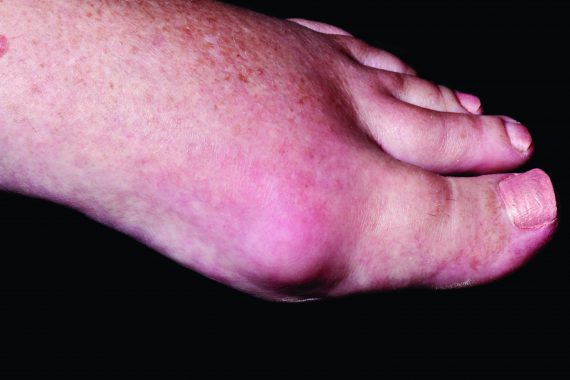Guideline of the month: intervening earlier to manage gout

The guideline
The British Society for Rheumatology has updated its guideline to include new advice on acute attacks, lifestyle modification and optimal use of urate-lowering therapy.
Key points for GPs
- Urate-lowering therapy should be offered to all patients who have a diagnosis of gout. Starting therapy is best delayed until inflammation has settled.
- Allopurinol is the recommended first-line urate-lowering drug.
- The target serum uric acid level has now been reduced to 300µmol/l.
- Educate patients to treat acute attacks as soon as the attack occurs. Urate-lowering therapy should be continued throughout an attack.
- An NSAID at maximum dose, or colchicine at doses of 500μg, are the drugs of choice for managing acute attacks where there are no contraindications.
- Corticosteroid injections are effective for monoarticular gout and should be considered in those with comorbidities.
- In patients with acute gout where response to monotherapy is insufficient, combinations of treatment can be used.
Practical issues
The guideline calls for a change from what is currently common practice: GPs will need to discuss urate-lowering therapy with patients on first presentation, checking urate after the first attack. The document also advises that GPs offer ‘written and verbal’ information on lifestyle and prevention.
Expert comment
Dr Louise Warburton, a GPSI in musculoskeletal medicine in Telford, says: ‘The updated guideline encourages GPs to take gout more seriously. Traditionally, we have tended to reserve discussions about urate-lowering therapy to the second or third attack. Now we’re advised to explain the risks of gout and forewarn patients of the need for therapy.
‘Allopurinol is still the drug of choice but should be started at a low dose of 50-100mg daily and then increased every four weeks until target urate levels are reached. This is probably much faster than we would normally consider.’
The guideline
This article was corrected and updated on 10 July 2017. It originally implied that urate-lowering therapy would need to be started before a first attack of gout.
Pulse October survey
Take our July 2025 survey to potentially win £1.000 worth of tokens

Visit Pulse Reference for details on 140 symptoms, including easily searchable symptoms and categories, offering you a free platform to check symptoms and receive potential diagnoses during consultations.










